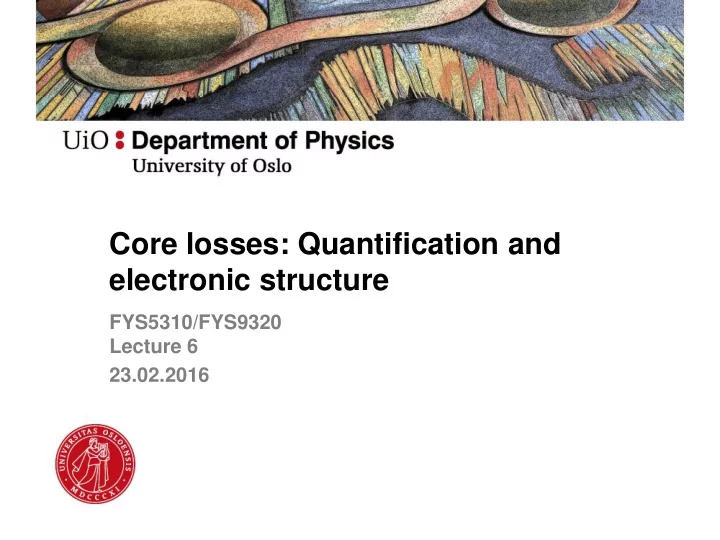

Core losses: Quantification and electronic structure FYS5310/FYS9320 Lecture 6 23.02.2016
2
Elemental quantification • The core loss EELS edges can be used to quantify the composition of your specimen • In particular useful for low-Z elements 3
The fluorescence yield in EDS analysis The probability for generating a characteristic X-ray is given by the fluorescence yield w The probability of generating an Auger electron is the 1- w. Very few X-ray generated F&H
Elemental quantification • The core loss EELS edges can be used to quantify the composition of your specimen • In particular useful for low-Z elements • You also avoid some of the experimental errors of EDS 5
Spurious and system X-rays in EDS analysis • Spurious X-rays from the specimen, but not the region of interest • System X-rays from the sample holder, specimen support grid, microscope itself (Cu, Fe) W&C
Elemental quantification • The core loss EELS edges can be used to quantify the composition of your specimen • In particular useful for low-Z elements • You also avoid some of the experimental errors of EDS (spurious and system X-rays) • In the first approximation, the observed intensity I of edge i of element A is: 𝑗 = 𝐽 0 𝑂 𝑗 𝐽 𝐵 𝐵 𝜏 𝐵 • Relative composition is then 𝑘 𝑗 𝑂 = 𝐽 𝐵 𝜏 𝐶 𝐵 𝑗 𝑘 𝑂 𝐶 𝜏 𝐽 𝐶 𝐵 7
Boron K edge Nitrogen K edge 8
What scattering cross section do we use? 1 2 9
What scattering cross section do we use? Sample Collection angle To prism 10
What scattering cross section do we use? • In practice, our experiment looks only at inelastic scattering in an energy range [E,E+ ] and scattering angle [0, ] Partial cross section ( , ) must be used • 11
12
Geometry of the experiment Incident beam convergence angle Microscope in Collection angle determined by imaging mode size of microscope objective apperture diffraction mode size of spectrometer entrance apperture Sample GIF entrance apperture or Microscope objective apperture Collection angle 13 To prism
How to determine partial cross sections • Calculations – Hydrogenic model – Hartree-Slater model • Experimentally 14
Background removal Power law model: 15
Plural scattering • Remove using Fourier-ratio or Fourier-log methods 16
Free atom cross sections compared to spectra from materials 17
18
Under usual assumtions, the core loss EELS spectrum probes the • local density of states around the excited atom… • with symmetry l 1… • above the Fermi-level The site and symmetry selected DOS 19
L 2 L 3 20
L 2 L 3 21
22
The 3d orbitals 23
Let’s imagine octahedral coordination 24
Ti 3d orbitals 25
e g t 2g e g t 2g L 2 L 3 26
Direct comparison with calculated density of states (DOS) • The transition matrix determines the underlying edge shape • Usually slowly varying with energy • The density of states gives more rapid variations on top of this • Allows comparison with calculated DOS, e.g. from density functional theory (DFT)
Direct observations of charge transfer in copper oxide Cu 2+ O 2− Charge is transferred from copper atom towards oxygen because of + O 2− Cu 2 greater electronegativity Cu metal V. J. Keast et al. J. Microsc. (2001)
Oxygen 2p DOS of AlV 2 O 4
The core hole problem • We have so far assumed that the probed DOS is the ground state DOS • But we are explicitly exciting the system out of the ground state E F • Coloumb interaction between electron and hole Change in electrostatic potential change • in the DOS and rearrangement of charge
The core hole problem SiO 2 as an example p s,d Si L 2,3 Experiment s and d DOS with core hole s and d ground state DOS • The core hole should in principle always be accounted for s p O K • Neglecting the core hole sometimes works well or even better (metals), other p ground state DOS times not (insulators and Experiment oxides) J. B. Neaton et al . Phys. Rev. Lett. (2000)
• If the initial states are sharply peaked in energy, then all transitions originate at this energy • One particular E i and one particular E takes you to a single point in the conduction band E f • In effect we are convoluting the conduction band DOS with a delta function 𝐸𝑓𝑚𝑢𝑏 𝑔𝑣𝑜𝑑𝑢𝑗𝑝𝑜 ⊗ 𝑑𝐸𝑃𝑇 = 𝑑𝐸𝑃𝑇 • But what if the initial states are in the valence band? 𝑤𝐸𝑃𝑇 ⊗ 𝑑𝐸𝑃𝑇 =? • Topic for next time 32
Recommend
More recommend